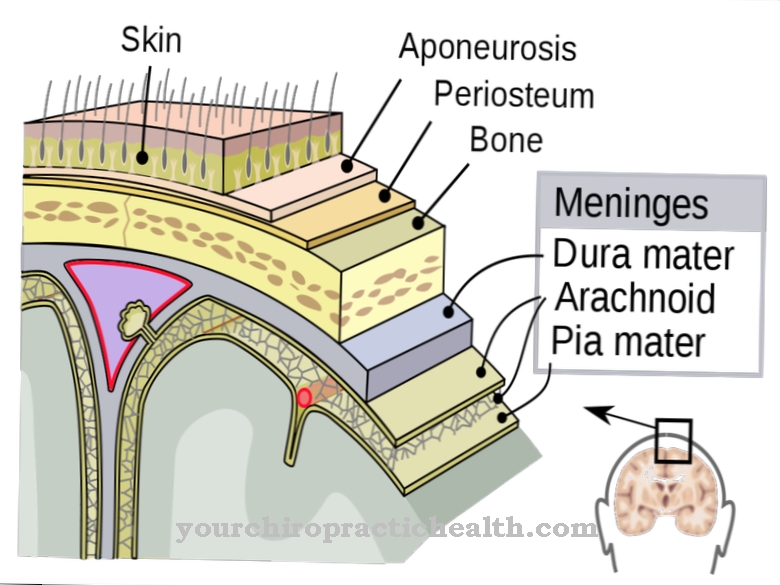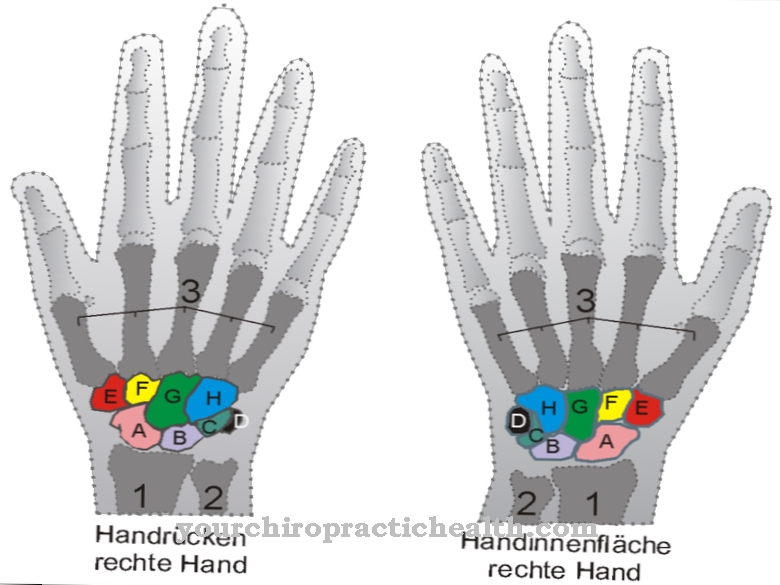The Skullcap, in Latin Calvaria, is the bony roof of the skull and consists of flat, flattened bones (Ossa Plana). It is also part of the neurocranium, the skull, and at the same time the bone that encompasses the brain.
The flat bones are connected by so-called sutures: These are seams between two bones that consist of connective tissue. Since sutures are fake joints, they grow together into ossified synostoses with increasing age; Synostoses are the fusion of bones that were once connected to each other by connective tissue.
What is the skullcap?
The skullcap serves to protect the brain and the sensory organs and thus prevents damage to the brain. Due to its shape, it is reminiscent of a helmet, especially due to the flat bones (Ossa plana).
Anatomy & structure
The calvaria is divided into the following four bones:
- Frontal bone (os frontale),
- two parietal bones (os parietale, pl. ossa parietalia),
- and occipital bone (Os occipitale).
These bones are connected by the sutures, the connective tissue seams between bones.
The frontal bone can be seen as part of the facial skull; it forms the anterior roof of the skull and thus the upper wall of the skull cavity. The two parts of the frontal bone are also connected to one another by a bone suture. The frontal bone is divided into three sections, the frontal bone scale (Squama frontalis), the pars orbitalis, which forms the orbital roof, and the pharynx (Greek for "throat").
The frontal bone scale is the largest part of the frontal bone, it forms the forehead area and lies above the orbit (eye sockets). It contains the so-called frontal sinuses, which are filled with air. They are created in pairs and covered with a mucous membrane. The frontal sinuses are separated from each other by a septum and open into the middle nasal passage. In addition, the Squama frontalis is divided into an inner and an outer surface.
The outer surface of the squama frontalis (frontal bone scale) is arched and usually shows an anterior suture that connects two front bones. The frontal tuberosities are located on both front bones in the middle area. These look mostly asymmetrical and look different for everyone; they are particularly common in the skulls of young people.
Under the frontal tuberosities on the lower part of the frontal bone are the eyebrow arches, which are connected by the so-called glabella, the skin region between the eyebrows.
The part of the pars orbitalis consists of two thin, triangular plates, the orbital plates; these together form a bulge between the orbitals.
The parietal bones form a central part of the skullcap and lie below the vertex. They are located on both sides of the skull and form large parts of the skullcap and the side wall of the ossified brain capsule. They are curved inwards on the inside (concave) and on the outside they are curved outwards (convex). On the inside of the parietal bones, furrows of the arteries run, which displace the bones due to arterial pressure.
The parts of the parietal bone are connected to one another by three sutures: the sagittal suture connects the left and right parietal bones, the coronal suture connects the parietal bone to the frontal frontal bone and the lambdoidal suture connects it to the occipital bone. There are small holes in the bones for vessels, so-called foramina parietalia, through which the emissary veins run, among other things.
The occiput, or os occipitale, is the third part of the skullcap and is located near the junction of the neck, thus forming the rear end of the cranial cavity. There is also an opening in the occipital bone for the twelfth cranial nerve (Canalis nervi hypoglossi), one of the nerves that arise directly from nerve collections in the brain. The occiput is divided into three parts:
- Part of the base belonging to the posterior base of the skull,
- Side part,
- Occipital scale, the back.
Function & tasks
As part of the entire skull, the skullcap is responsible for protecting the brain as well as blood vessels, lymph vessels and nerves. There are also several openings in the roof of the skull for cranial nerves and veins. In addition, the skullcap gives the head its round shape.
Diseases
The most well-known impairment of the skull roof is the skull cap fracture: This is a multiple fracture of the skull roof and can result from a swelling of the brain or soft tissue.
A break can also damage cranial nerves, veins, and other vessels. Symptoms of a skull fracture can vary, but include bruising under the eyes, swelling of the eyelids, or an impaired sense of smell. Another disease that can be associated with the bone is bone metastases, which are daughter ulcers and developed through a spatially separated tumor. Signs of a metastasis are bone pain, especially in the neck in the case of a calotte metastasis.
























.jpg)



